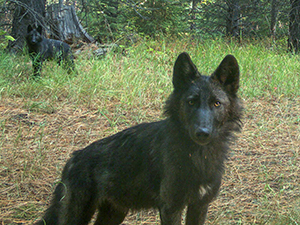Idaho’s wolf population has remained stable and consistent over the last three years based on camera surveys done last summer and since 2019. The 2021 population estimate for Aug. 1 was 1,543 wolves. The 2020 and 2019 estimates were 1,556 and 1,566.
Idaho Fish and Game staff deploy cameras during summer when Idaho’s wolf population is near its annual peak. Biologists then monitor hunting, trapping, and other sources of mortality throughout the year to understand how the population varies from late spring when pups are born and throughout fall and winter when most hunting and trapping occurs.
“The population estimate is a valuable tool to measure the effectiveness of Fish and Game Commission’s wolf management and provide the public with a clear understanding of that management,” Idaho Fish and Game Director Ed Schriever said.
Documented mortality from July 1 through Dec. 31, 2021, was 300 wolves, which is 37 more than July through December of 2020, and 36 fewer than the same period in 2019, which was a record year for wolf harvest.
Most wolves are taken by hunters and trappers each year. Other mortality includes wolves killed during, or after, preying on livestock, and wolf management done by Fish and Game to reduce pressure on elk herds, as well as natural mortality.
Documented wolf mortality in Idaho over the last 5 years (2016 through 2020) has averaged 436 wolves annually. Wolf mortality is tracked from July through June rather than a calendar year.
In an effort to reduce wolf conflicts with livestock and elk herds, the Idaho Fish and Game Commission in 2021 expanded wolf seasons and hunting and trapping methods. The Idaho Legislature also passed SB1211, which further expanded methods of take and extended trapping seasons, mostly on private lands, in an effort to decrease depredation on livestock. Many of those enhanced methods did not take effect until July 1, 2021.
Documented human-caused mortality, along with estimates of natural mortality and reproduction rates, allow Fish and Game biologists to understand the annual wolf population cycle and estimate the minimum population at approximately 900 wolves in early spring before pups are born.
“It is important to understand both the annual population cycle and longer-term population trend from year to year,” Schriever said.
Idaho has committed to maintaining at least 150 wolves, Schriever said, and the Idaho Fish and Game Commission intends to manage for a smaller wolf population than the current number in order to reduce conflicts with livestock and manage a balance between wolves and their prey, which is primarily elk.
The Commission’s intent is similar to the U.S. Fish and Wildlife Service’s delisting criteria, which suggests a management range of about 500 wolves in Idaho. That number would likely reduce wolf and livestock conflicts while still maintaining a sustainable wolf population and also help elk herds in areas that are not meeting management goals.
The Fish and Wildlife Service’s 2009 delisting rule stated that more than 1,500 wolves across the entire Northern Rocky Mountain recovery area would “slowly reduce wild prey abundance in suitable wolf habitat” and “high rates of livestock depredation in these and surrounding areas would follow.”
The Fish and Wildlife Service’s delisting rule called for about 1,100 wolves within the Northern Rocky Mountains, which means Idaho’s population alone would meet the service’s objectives for Idaho, Montana, Wyoming and other states.
Idaho is the first state to use remote cameras to produce a statewide estimate of the wolf population, which is a method pioneered by a collaboration between the University of Montana and Idaho Fish and Game researchers.
To get the latest population estimate, Fish and Game crews deployed 533 cameras in July and August of 2021 that collected about 9 million photos. Then they used specialized computer software to identify photos that contained pictures of animals, and Fish and Game staff categorized those pictures by species.
Wolf monitoring is integrated into a larger statewide project that uses game cameras to estimate populations for a variety of species and complements other methods of surveying wildlife.
Also see:
— CBB, Sept. 16, 2021, USFWS SAYS LISTING WOLVES AGAIN UNDER ESA MAY BE WARRANTED, LAUNCHING STATUS REVIEW https://cbbulletin.com/usfws-says-listing-wolves-again-under-esa-may-be-warranted-launching-status-review/
— CBB, May 7, 2021, IDAHO GOVERNOR SIGNS BILL ALLOWING KILLING OF 90 PERCENT OF STATE’S WOLVES https://cbbulletin.com/idaho-bill-allowing-killing-of-90-percent-of-states-wolves-awaits-governors-decision-to-sign/
— CBB, Oct. 30, 2020, TRUMP ADMINISTRATION DE-LISTS ALL GRAY WOLVES IN LOWER 48, TURNS MANAGEMENT OVER TO STATES,TRIBES https://cbbulletin.com/trump-administration-de-lists-all-gray-wolves-in-lower-48-turns-management-over-to-statestribes/

